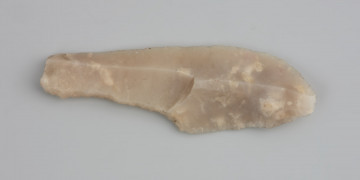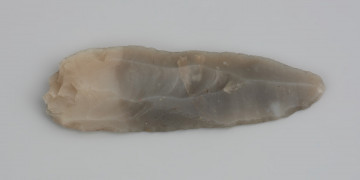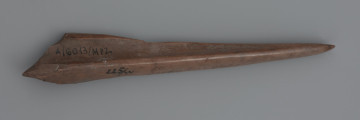
Single-jagged edge
11900 p.n.e. — 11000 p.n.e.
National Museum in Szczecin
Part of the collection: Stone Age
The bone blade from Kosierzewo, the Sławno district, was accidentally discovered before 1887 in a peat bog in a layer of lacustrine chalk at a depth of approx. 6 m and was donated to the collection of the Gesellschaft für Pommersche Geschichte und Altertumskunde in Szczecin. The first stage in the blade production was the gouging of longitudinal recesses in the long bone, making it possible to break off the part intended for further processing with flint tools. After scraping and planing, characteristic longitudinal and transverse marks in the form of long lines and striations were preserved on the blade surface. Small incisions are also visible, giving the impression of intentional ornamentation, but they are too shallow to say for sure. The excellent preservation of the treatment marks is an indication that the blade was not used at all, or only occasionally, not very intensively. Bone blades were commonly used by the hunter-gatherer peoples of the Middle Stone Age, inhabiting the forests of northern Europe. They were used as arrowheads, javelins or spears. Many of them were discovered by accident during industrial peat extraction in the 19th century. Blades of this type are difficult to date precisely without the implementation of physicochemical methods such as radioactive carbon (14C) dating.
Michał Adamczyk
Author / creator
Dimensions
cały obiekt: height: 17 cm, width: 0.7 cm
Object type
blade, arrowhead
Technique
cutting, smoothing, planing, scraping
Material
bone
Origin / acquisition method
acquisition
Creation time / dating
Creation / finding place
Owner
National Museum in Szczecin
Identification number
Location / status

11900 p.n.e. — 11000 p.n.e.
National Museum in Szczecin

11900 p.n.e. — 11000 p.n.e.
National Museum in Szczecin

9600 p.n.e. — 4100 p.n.e.
National Museum in Szczecin
DISCOVER this TOPIC
Castle Museum in Łańcut
DISCOVER this PATH
Educational path